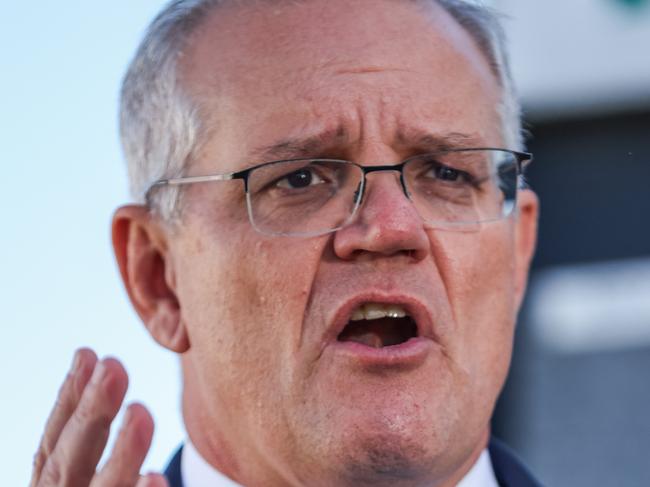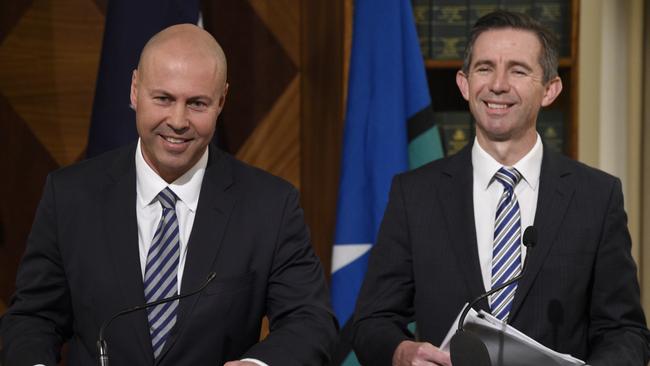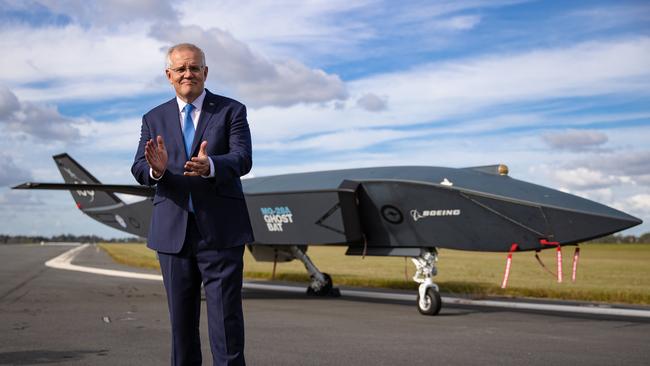Federal Election 2022: Labor and Coalition policies compared
Before casting your vote, see the Coalition and Labor’s policy commitments, how they compare and what it means for you and your household.
Federal Election
Don't miss out on the headlines from Federal Election. Followed categories will be added to My News.
With Australians heading to the polls on Saturday here are the Coalition and Labor’s policy commitments and how they compare.
Plus: Use our calculator and see which policy is best for you.
Housing
Use a slice of your super to help with a house deposit or have the government buy a chunk of your first home?
The contrasting offerings for first homebuyers is the undisputed main event on this election’s policy fight card.
In what the PM calls a “game-changer”, the Coalition will let first homebuyers to tap into $50,000 or 40 per cent of their superannuation to put toward a house.
To increase housing supply, empty-nesters aged 55 or over will be encouraged to downsize with the lure of pumping $300,000 of the sale proceeds into their super fund without penalty.
The Coalition will also more than triple the number of places in its Home Guarantee Scheme, allowing first homebuyers to buy property with a deposit as low as 2 per cent, and offer additional places to single-parent families and invest $2bn to build more affordable housing.
Labor are trumpeting its Help to Buy scheme, which will see an Albanese government provide up to 40 per cent equity contribution for 10,000 Australians a year to buy a home.
Labor says the policy, available for people who have a deposit as low as 2 per cent and would allow people to save up to $1500 on mortgage repayments every month.
However, the party acknowledges participants must buy out the government or sell the home if their income rises beyond $90,000 for singles or $120,000 for couples.

Wages
Prime Minister Scott Morrison said he supports a “sustainable” wage rise – including to minimum wage – but wouldn’t outline how much he thinks it should be.
Opposition Leader Anthony Albanese said he would “absolutely” support Australia’s lowest paid workers getting a 5.1 per cent pay increase, but has refused to outline if Labor would lobby for this specific pay bump with the Fair Work Commission.
Childcare
The Coalition has not revealed any new measures to lift the childcare subsidy, but announced in March it had lifted the subsidy rate by 30 percentage points for a second child, up to a maximum rate of 95 per cent. The government says families who earn $120,000 a year with two children in child care will save $144 per week compared to previous settings.
Labor has announced plans to boost childcare subsidies to 90 per cent for low-income earners, which it says will save families up to $80 a week for one child. Under the policy families earning up to $530,000 will receive an increase in the childcare subsidy. Labor says families with two or more children will receive a higher subsidy rate for second and subsequent children than they would under the Coalition.
Healthcare
The Coalition has pledged to lower the cost of medicines on the Pharmaceutical Benefits Scheme by $10, which would cap costs at $32.50. It would be a $120 a year saving to any one-on-one script per month. It will also lower the PBS Safety Net program which it says, coupled with an eligibility expansion of the Seniors Health Card, could see millions of people save up to $80 each year.
Labor will match the Coalition’s Seniors Health Card expansion and has gone further on the PBS by promising to lower the cost of medicines by $12.50 – which would deliver an annual saving of up to $150. Labor also recently announced a $970m plan — made up of a fund worth $720m and a grant scheme worth $250m - to “strengthen Medicare”.

Aged care
The Coalition lifted funding for aged care by $18.8bn through to 2025/26 to implement Royal Commission reforms, has agreed to lift minimum care standards to 200 minutes a day, ensure nurses for at least 16 hours, and will “respect” any decision on higher wages for workers made by Fair Work Commission.
Labor will match Coalition’s $18.8bn funding boost and add $2.5bn on top, will lift minimum care standards to 215 minutes per day, ensure nurses 24 hours, improve food and nutrition standards, and advocate wage rise for workers via the FWC and fund the outcome. Questions remain on how it will get enough nurses and how much wage rises will cost.
Power
Labor says modelling of its clean energy policies show power bills would be reduced by $275 a year by 2025, however the Opposition has offered no indication of how it would ease short term cost of living pressures. Experts have also noted international markets could affect its promoted savings.
The Coalition hasn’t released any new plan to tackle rising energy costs, but Mr Morrison has trumpeted his record on power bills which have fallen 8 per cent in the past two years. The government says its investment in new energy generation will put downward pressure on prices.
Environment
The Coalition’s climate target is to hit net zero by 2050 through “technology not taxes”, with a long-held 2030 target of 26 to 28 per cent emissions reductions. In the recent budget an extra $1bn was set aside for the Great Barrier Reef over the decade, bringing the total investment for the Reef 2050 plan to $3bn.
Labor’s target is net zero emissions by 2050, with a 2030 goal of 43 per cent. The Opposition also announced it would back in the government’s $1bn investment and add another $194.5m for reef related programs and other items like the eradication of invasive species.
Fuel
Mr Morrison has ruled out an extension of the fuel excise tax cut beyond September. He says the tax cut introduced in the budget has put downward pressure on the cost of transportation of critical goods such as groceries.
Labor will also not extend the measure, which will cost the government almost $3bn in lost revenue.

Taxes
The Coalition in this year’s Budget announced a one-off $420 cost of living tax offset. Millions of eligible taxpayers would now receive up to $1500 per person or $3000 for couples in tax relief from July 1. Prime Minister gave an “iron-clad guarantee” that if re-elected the government won’t raise taxes in the life of the next parliament.
Labor has abolished the higher tax agenda it took to the 2019 election and will support the government’s $420 offset for low-and-middle income earners this year. Party has also explicitly rejected the Government’s pledge to cap taxation at 23.9 per cent of GDP. The only new tax is one on multinationals, which includes cracking down on businesses using tax havens.
Women
Labor will work to close the gender pay gap by advocating through the FWC to raise wages in “care” sectors, promised 10 days of family and domestic violence leave, and 500 new community sector workers to support women in crisis. It has also committed to implementing all 55 recommendations of the Respect@Work report, and will establish a new Family, Domestic and Sexual Violence Commissioner.
Coalition announced in budget a plan for more flexible parental leave where working parents share up to 20 weeks of Government funded time off. Party also claims 43 of 55 recommendations of the Respect@Work report are fully implemented or fully funded with over $70 million committed, with work underway on all of the recommendations.

NDIS
Labor has announced a six-point plan to improve the NDIS, which includes fixing regional access; stopping cuts to plans; boosting efficiency; reducing wasteful administrative expenses; putting more disabled people on the board of the National Disability Insurance Agency, and boosting staffing levels at the NDIA.
The Coalition has not released any election-specific NDIS policy. The NDIS will overtake spending on defence in 2024-25, and will cost federal and state governments collectively $46 billion annually in 2025-26, according to the latest budget papers.
National security
The Coalition has lifted Defence spending above 2 per cent of GDP ($48bn in 2022/23) and plans to spend another $575bn over the next decade. Has promised to increase Australia’s Defence workforce by 18,500 people over the next 18 years into 2040. Announced $9.9bn in funding over the decade for new cyber security and intelligence capabilities.
Labor has committed to keeping Defence spending above 2 per cent of GDP and supports the Coalition’s national security settings. Labor has pledged to spend money on defence more effectively.

Government accountability
Labor wants to legislate an independent anti-corruption body “with teeth” by the end of 2022.
The Coalition is adamant its version, which was released as an exposure draft, is the suitable ICAC model that should be stood up. That version has no ability to conduct public hearings for government corruption, despite allowing such hearings for law enforcement matters.
Foreign affairs and the Pacific
Mr Morrison says his government is “investing” in the relationship with Pacific neighbours particularly through the multi-billion Pacific Step Up program.
Labor has responded to the crisis to pitch up its own Pacific strategy, with heavy focus on “soft power” like reinstating broadcast media into the region if elected, aerial surveillance of Pacific Island countries’ exclusive economic zone and an extra $525m spend over four years in the region.
Jobs and training
The Coalition promises it will create “another 1.3m jobs” over five years in a plan that includes spending $3.7bn on skills training to create 800,000 extra spots, $7.1bn to fund “transformative infrastructure projects” and “$2 billion to drive growth and productivity” through the Regional Accelerator Program.
Labor has not set a whole-of-government jobs creation number, but has nominated figures across a few policy areas. The party reckons its emissions reduction and renewable energy plan can create 604,000 jobs, and it also has a goal of creating 1.2m tech related jobs by 2030. Labor also wants to create 465,000 fee-free TAFE places - including 45,000 new spits - for students studying in industries with a skills shortage.
More Coverage
Originally published as Federal Election 2022: Labor and Coalition policies compared





